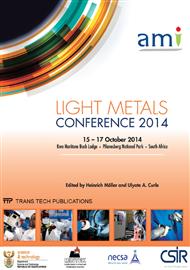[1]
Department of Mineral Resources, A beneficiation strategy for the minerals industry of South Africa, (2011).
Google Scholar
[2]
C.K. Gupta, N. Krishnamurthy, Extractive Metallurgy of Rare Earths. Boca Raton, Florida: CRC Press, (2005).
Google Scholar
[3]
N. Clavier, R. Podor, N. Dacheux, Crystal chemistry of the monazite structure, Journal of the European Ceramic Society. 31 (2011) 941 - 976.
DOI: 10.1016/j.jeurceramsoc.2010.12.019
Google Scholar
[4]
A.M. Abdel-Rehim, An innovative method for processing Egyption monazite, Hydrometallurgy. 67 (2002) 9 - 17.
DOI: 10.1016/s0304-386x(02)00134-2
Google Scholar
[5]
R.D. Abreu, C.A. Morais, Purification of rare earth elements from monazite sulphuric acid leach liquor and the production of high purity ceric oxide, Minerals Engineering, 23 (2010) 536 - 540.
DOI: 10.1016/j.mineng.2010.03.010
Google Scholar
[6]
T.A. Blench, The Steenkampskraal rare earths and thorium project in South Africa, Thorium and Rare Earths Conference, Cape Town (2010) 45 - 57.
Google Scholar
[7]
C. Hurst, China's rare earth elements industry: What can the west learn, Institute for the Analaysis of Global Security, Memo (2010).
DOI: 10.21236/ada525378
Google Scholar
[8]
W. Kim, I. Bae, S. Chae, H. Shin, Mechan0chemical decomposition of monazite to assist extraction of rare earth elements, Journal of alloys and compounds, 486 (2009) 610 - 614.
DOI: 10.1016/j.jallcom.2009.07.015
Google Scholar
[9]
E. Kim, K. Osseo-Asare, Aqueous stability of thorium and rare earth metals in monazite hydrometallurgy: Eh - pH diagrams for the system Th-, Ce-, La-, Nd- (PO4)-H2O at 25 °C, Hydrometallurgy, 113 - 114 (2012) 67 - 78.
DOI: 10.1016/j.hydromet.2011.12.007
Google Scholar
[10]
J.T. Nel, W. du Plesis, P.L. Crouse, W.L. Retief, J.P. le Roux, J.L. Havenga, C.J. Pretorius, PCT Patent No. PCT/IB2012/055511 (2013).
Google Scholar
[11]
J.T. Nel, W. du Plesis, P.L. Crouse, W.L. Retief, PCT Patent No. PCT/IB2010/054067 (2010).
Google Scholar
[12]
J.T. Nel, W. du Plesis, P.L. Crouse, W.L. Retief, Patent No. WO 2011/013085 (2010).
Google Scholar
[13]
C.J. Pretorius, W du Plessis, J.T. Nel, P.L. Crouse, Kinetics and thermodynamic parameters for the manufacturing of anhydrous zirconium tetrafluoride with ammonium acid fluoride as fluorinating agent, J. SAIMM, 7A (2012) 601 - 604.
Google Scholar
[14]
W.G. Augustyn, S. Monnahela, J.T. Nel, D. Hudson-Lamb, R.I. McCrindle, L. Marjanovic, The purification of zirconium tetrafluoride to nuclear grade by vacuum sublimation, Thorium and Rare Earths Conference, Cape Town (2010) 177 - 186.
Google Scholar
[15]
Manson Benedict, Thomas H Pigford, Hans Wolfgan Levi, Nuclear Chemical Engineering, second ed, McGraw Hill, (1957).
DOI: 10.1002/aic.690280428
Google Scholar
[16]
C. Lemaignan, Metallurgy of Zr alloys for Nuclear Applications, April 21 - 25, (2008).
Google Scholar
[17]
Ux Consulting Services, Nuclear Zirconium Alloy Market, Ux Consulting, Roswell (2013).
Google Scholar
[18]
H. Li, H.K. Nersisyan, K. Park, T. Park, J. Kim, J. Lee, J. Lee, Nuclear grade zirconium prepared by combining combustion synthesis with molten-salt electrofining technique, Journal of Nuclear Materials, 413 (2011) 107-113.
DOI: 10.1016/j.jnucmat.2011.04.008
Google Scholar
[19]
I. Toumanov, Plasma and High Frequency Processes for Obtaining and Processing Materials in the Nuclear Fuel Cycle. Hauppauge (New York): Nova Science Publishers, Inc. (2003).
Google Scholar
[20]
Outotec Research, HSC Chemistry, (2014).
Google Scholar
[21]
J.M. Smith, H.C. van Hess, M.M. Abbott, Introduction to Chemical Engineering Thermodynamics, 7th ed. McGraw Hill., Singapore, (2005).
Google Scholar
[22]
J.C. Kotz, P.M. Treichel, Jr, P.A. Harman, Chemistry and Chemical Reactivity, 5th ed.: Thompson Brooks/Cole, (2003).
Google Scholar
[23]
C.B. Yeamans, Synthesis of uranium fluorides from uranium dioxide with ammonium bifluoride and Ammonolysis of Uranium Fluorides to Uranium Nitrides.: Proquest, (2008).
DOI: 10.1016/j.jnucmat.2007.06.022
Google Scholar
[24]
B.N. Wani, S.J. Patwe, U.R.K. Rao, and K.S. Venkateswarlu, Fluorination of oxides of uranium and thorium by ammonium hydrogen fluoride, J. Fluor. Chem, 44 (1989) 177 - 185.
DOI: 10.1016/s0022-1139(00)83937-8
Google Scholar


